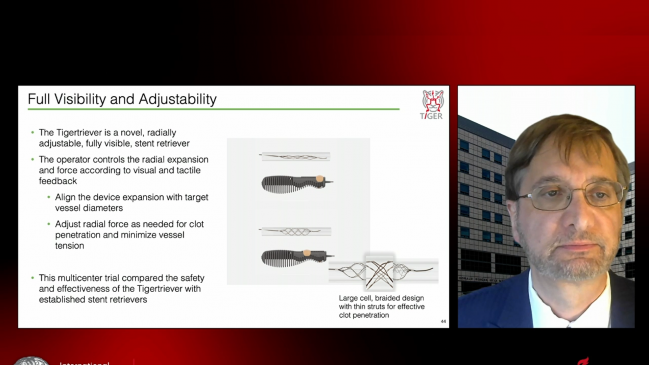Adjustable Stent Retriever Performs Well in IDE Trial
The “impressive” results with the Tigertriever likely also reflect broad progress in acute stroke interventions, Patrick Lyden says.

A novel, radially-adjustable stent retriever—called Tigertriever (Rapid Medical)—provides high rates of reperfusion and good clinical outcomes, with favorable safety, in patients with acute ischemic strokes caused by large-vessel occlusions, results of the TIGER trial show.
The primary efficacy outcome was successful revascularization (mTICI 2b-3) within three passes of the device, and this was achieved in 84.6% of patients, exceeding a performance goal based on six prior trials (63.4%; P = 0.0001).
Good functional status at 90 days, defined by a modified Rankin Scale (mRS) score of 0 to 2, was achieved by 58% of patients, superior to the historical control rate of 43% (P = 0.0006).
In terms of safety, the composite of symptomatic intracranial hemorrhage (ICH) at 24 hours or all-cause mortality at 90 days occurred in 18.1% of patients in the trial, which was noninferior to the 20.4% historical control rate and superior to the 30.4% performance goal (P = 0.004). The rate of symptomatic ICH was 1.7%.
“The Tigertriever is a highly effective and safe device to remove thrombus in patients with large-vessel occlusion who are eligible for mechanical thrombectomy,” said Rishi Gupta, MD (Wellstar Kennestone Hospital, Marietta, GA). He presented the results along with Jeffrey Saver, MD (University of California, Los Angeles), during the virtual International Stroke Conference 2021 last week. The trial was published simultaneously online in Stroke.
The TIGER Trial
Stent retrievers have already proven their mettle for the treatment of large-vessel occlusions in several trials, but the technology still has some limitations, Saver said. He pointed to the failure to achieve successful reperfusion in about one-quarter of patients and excellent reperfusion in about two-thirds, as well as “not infrequent” complications like embolization to a new territory and symptomatic ICH. “As a result, further advancements in retriever technology are highly desirable,” he said.
With the Tigertriever, which has not been approved for use in the United States but has CE Mark approval in Europe, operators can control the radial expansion and force, allowing them to match device expansion with target-vessel diameters and adjust the force needed to engage the clot while minimizing tension on the vessel. It’s also fully visible on imaging, providing better visual feedback and operator control, Saver said.
The TIGER study, an investigational device exemption (IDE) trial, was performed at 16 sites in the US and one in Israel and evaluated two sizes of the device: the Tigertriever (diameter 1.5 to 6 mm) and the Tigertriever 17 (diameter 0.5 to 3 mm). It included 43 patients enrolled during a lead-in phase and 117 in the main study phase. Overall, mean patient age was 65, and 61.5% were men. The median NIHSS score was 17, and two-thirds of participants received IV thrombolysis before the procedure.
I think really what’s going on here is the surgeons and operators are getting better and more experienced and having more volume and more comfort with the procedures. Patrick Lyden
Median workflow times included 24 minutes from puncture to revascularization, which Gupta said was “very rapid,” 172 minutes from when the patient was last known well (LKW) to puncture, and 208 minutes from LKW to revascularization. Median procedure time was 43 minutes.
The device provided favorable results on several efficacy and safety outcomes beyond the primary endpoints. Successful revascularization was achieved in just one pass of the device in 57.8% of cases, for instance.
Asymptomatic ICH within 24 hours was observed in 30.7% of patients, whereas low rates were seen for neurological deterioration within the first 24 hours (7.7%) and embolization to a previously uninvolved vascular territory (2.6%). The latter rate was significantly lower than the 7.4% rate recorded in historical controls (P = 0.04).
Safety and efficacy outcomes were similar when looking at the main study phase or the overall cohort encompassing the lead-in and main study phases, Gupta said. Key findings compared favorably with averaged results from three prior IDE trials stent retrievers, he reported.
Results ‘Better Than Expected’
Patrick Lyden, MD (University of Southern California, Los Angeles), chair of the American Heart Association/American Stroke Association Stroke Council, told TCTMD he was surprised by the findings. “The results are impressive and better than expected, I think, and quite robust.”
There are two potential explanations, Lyden said. “One is that the device is intrinsically better, but the more likely explanation is that the field has advanced considerably and that the surgeons and other users are more experienced.” He pointed out that the outcomes achieved by the Tigertriever are being compared with those achieved by other stent retrievers in trials conducted several years ago.
That said, Lyden indicated that he believes the Tigertriever is at least comparable to other similar devices in terms of efficacy and safety. One note of caution, he added, is that many of the procedures were performed at just a handful of experienced centers, which raises questions about how the device would perform with wider availability in the community. But that’s true of many device studies, he stressed.
Taking a broader view of stroke interventions, Lyden said he thinks that while “the technology enhancements are interesting, and sometimes they’re breakthrough,” what it comes down to when looking at procedural outcomes is operator experience and case volume.
“This device looks a little better than the other devices, but I think really what’s going on here is the surgeons and operators are getting better and more experienced and having more volume and more comfort with the procedures,” Lyden said.
Todd Neale is the Associate News Editor for TCTMD and a Senior Medical Journalist. He got his start in journalism at …
Read Full BioSources
Gupta R, Saver JL, Levy E, et al. A new class of radially-adjustable stentrievers for acute ischemic stroke: primary results of the multicenter TIGER trial. Stroke. 2021;Epub ahead of print.
Disclosures
- The study was funded by Rapid Medical.
- Gupta serves as a principal investigator for the TIGER study (Rapid Medical), the ASSIST Registry (Stryker Neurovascular), the RECCLAIM II Study (Zoll), and the CLEAR Study (Vesalio); as a member of the clinical events committee for the MIND trial (Penumbra); and as a consultant for Cerenovus.
- Saver is a principal investigator for the TIGER study and reports serving as a consultant or advisory board member for Medtronic, Stryker, Cerenovus, and Rapid Medical; and having an institutional conflict of interest due to the University of California having patent rights in retrieval devices for stroke.




Comments